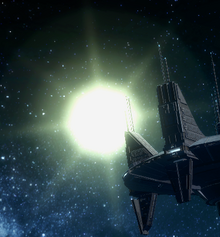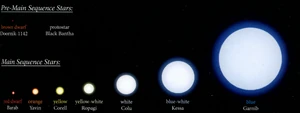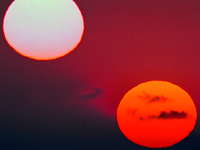m (→Appearances) |
m (→Appearances) |
||
| (5 intermediate revisions by 3 users not shown) | |||
| Line 1: | Line 1: | ||
{{Eras}} |
{{Eras}} |
||
| − | {{Quote|There are so many! Do they all have a system of planets?|A nine |
+ | {{Quote|There are so many! Do they all have a system of planets?|A nine year-old [[Anakin Skywalker]], looking at the stars|Star Wars Episode I: The Phantom Menace}}[[File:Makeb sun.png|thumb|right|220px|[[Makeb's sun|Starlight]] over the planet [[Makeb]].]] |
A '''star''' was an enormous sphere of immensely hot [[hydrogen]] and [[helium]] that underwent [[Wikipedia:nuclear fusion|nuclear fusion]]{{Fact}} to produce heat and light (in essence, it was a giant ball of [[plasma]]). [[Star system|Systems]] of [[planet]]s would usually form around stars when the gas and dust around them became stable enough. Stars could come in all sorts of sizes, colors, and temperatures. Most planets were seen orbiting medium mass orange-yellow stars, often called '''suns'''. |
A '''star''' was an enormous sphere of immensely hot [[hydrogen]] and [[helium]] that underwent [[Wikipedia:nuclear fusion|nuclear fusion]]{{Fact}} to produce heat and light (in essence, it was a giant ball of [[plasma]]). [[Star system|Systems]] of [[planet]]s would usually form around stars when the gas and dust around them became stable enough. Stars could come in all sorts of sizes, colors, and temperatures. Most planets were seen orbiting medium mass orange-yellow stars, often called '''suns'''. |
||
| Line 102: | Line 102: | ||
*''[[Splinter of the Mind's Eye]]'' |
*''[[Splinter of the Mind's Eye]]'' |
||
*''[[Empire and Rebellion: Razor's Edge]]'' |
*''[[Empire and Rebellion: Razor's Edge]]'' |
||
| − | *{{WEGCite|book=Shadows of the Empire Sourcebook|text=''Shadows of the Empire Sourcebook''|story=Permission Granted|stext=''Permission Granted''}} |
+ | *{{WEGCite|book=Shadows of the Empire Sourcebook|text=''Shadows of the Empire Sourcebook''|story=Permission Granted|stext=''Permission Granted''}} {{Hologram}} |
*''[[Star Wars 58: Sundown!]]'' |
*''[[Star Wars 58: Sundown!]]'' |
||
*''[[Star Wars 78: Hoth Stuff!]]'' |
*''[[Star Wars 78: Hoth Stuff!]]'' |
||
*[[Shadows of the Empire (novel)|''Shadows of the Empire'' novel]] |
*[[Shadows of the Empire (novel)|''Shadows of the Empire'' novel]] |
||
| + | *{{WEGCite|book=Shadows of the Empire Sourcebook|text=''Shadows of the Empire Sourcebook''|story=Hasty Exit|stext=''Hasty Exit''}} {{Mo}} |
||
| + | *{{WEGCite|book=Shadows of the Empire Sourcebook|text=''Shadows of the Empire Sourcebook''|story="Let's Go!"|stext=''Let's Go!''}} |
||
*''[[Out of the Closet: The Assassin's Tale]]'' |
*''[[Out of the Closet: The Assassin's Tale]]'' |
||
*[[Dark Forces: Rebel Agent audio drama|''Dark Forces: Rebel Agent'' audio drama]] |
*[[Dark Forces: Rebel Agent audio drama|''Dark Forces: Rebel Agent'' audio drama]] |
||
| Line 119: | Line 121: | ||
*''[[The Star Wars Sourcebook]]'' |
*''[[The Star Wars Sourcebook]]'' |
||
*''[[Star Wars Campaign Pack]]'' |
*''[[Star Wars Campaign Pack]]'' |
||
| + | *[[Galaxy Guide 2: Yavin and Bespin (First Edition)|''Galaxy Guide 2: Yavin and Bespin'', First Edition]] |
||
*[[Imperial Sourcebook (First Edition)|''Imperial Sourcebook'', First Edition]] |
*[[Imperial Sourcebook (First Edition)|''Imperial Sourcebook'', First Edition]] |
||
*[[Rebel Alliance Sourcebook (First Edition)|''Rebel Alliance Sourcebook'', First Edition]] |
*[[Rebel Alliance Sourcebook (First Edition)|''Rebel Alliance Sourcebook'', First Edition]] |
||
| + | *''[[Shadows of the Empire Sourcebook]]'' |
||
*''[[The Secrets of Star Wars: Shadows of the Empire]]'' |
*''[[The Secrets of Star Wars: Shadows of the Empire]]'' |
||
*{{SOTE|cardname=Dash's Secret Getaway|link=http://www.rebelscum.com/photo.asp?image=/sote/soteTC071.jpg}} |
*{{SOTE|cardname=Dash's Secret Getaway|link=http://www.rebelscum.com/photo.asp?image=/sote/soteTC071.jpg}} |
||
Revision as of 05:22, 21 August 2014
| | |
- "There are so many! Do they all have a system of planets?"
- ―A nine year-old Anakin Skywalker, looking at the stars

A star was an enormous sphere of immensely hot hydrogen and helium that underwent nuclear fusion[source?] to produce heat and light (in essence, it was a giant ball of plasma). Systems of planets would usually form around stars when the gas and dust around them became stable enough. Stars could come in all sorts of sizes, colors, and temperatures. Most planets were seen orbiting medium mass orange-yellow stars, often called suns.
It was estimated that there were four hundred billion stars in the galaxy. There were 7.1 billion habitable stars in the known galaxy, which made up about 3.2 billion habitable star systems. This means that many systems contained two or more stars.[1] Red dwarfs accounted for approximately 70 percent of the galaxy's stars.[2]
Characteristics
The parts of a star located above its surface were collectively referred to as the atmosphere. They comprised two principal zones: the chromosphere and the corona. The chromosphere was a gaseous, relatively cool layer located immediately above the surface, and the corona was the tenuous, rarefied gaseous outermost part of the atmosphere.[3]
Types of stars
- "Traveling through hyperspace ain't like dusting crops, boy! Without precise calculations we could fly right through a star or bounce too close to a supernova, and that'd end your trip real quick, wouldn't it?"
- ―Han Solo, to Luke Skywalker

Comparison of star types
There are seven types of main sequence stars in the galaxy:[1]
- "O" stars were blue and hot, and had a lifespan of less than one million years. There were approximately one hundred million habitable O stars in the galaxy. Example: Garnib.
- "B" stars were white-blue and hot, and had a lifespan of ten million years. There were approximately one hundred million habitable B stars in the galaxy. Example: Kessa.
- "A" stars were white and hot, and had a lifespan of four hundred million to two billion years. There were approximately one hundred million habitable A stars in the galaxy. Example: Colu.
- "F" stars were yellow-white and medium-temperature, and had a lifespan of four billion years. There were approximately one hundred million habitable F stars in the galaxy. Example: Ropagi.
- "G" stars were yellow and medium-temperature, and had a lifespan of ten billion years. There were approximately two billion habitable G stars in the galaxy. Example: Corell.
- "K" stars were orange and cool, and had a lifespan of sixty billion years. There were approximately 3.75 billion habitable K stars in the galaxy. Example: Yavin.
- "M" stars were red and cool, and had a lifespan of approximately one hundred trillion years. They were also called red dwarfs. There were approximately seven hundred million habitable M stars in the galaxy. Example: Barab.
With O stars being the biggest in the sequence, the size decreased gradually to the smallest M stars.

Tatoo I and Tatoo II, twin suns of the Tatoo system.
In addition to the main sequence stars, 10 percent of all stars in the galaxy were non-main sequence, of which five hundred million were habitable.
The non-main sequence stars include:[1]
Pre-main sequence (smaller than M stars):
- Brown dwarf. Example: Doornik-1142.
- Protostar. Example: Black Bantha.
Post main-sequence (bigger than O stars):
- Red giant. Example: Sokor.
- Blue giant. Example: Ku'Bakai.
- Red supergiant. Example: Primus Goluud.
Compact stars:
- White dwarf. Example: Ardos.
- Black dwarf. Example: The star of the Ring.
- Neutron star. Example: Din Pulsar.
- Black hole. Example: The Maw.
Behind the scenes
The OBAFGKM sequence is the same classification system used for identifying stars from Earth. However, in terms of Earth astrophysics, certain descriptions of stars in the Galaxy Far Far Away are shaky. Scientific bloopers abound such as blue supergiants that exist for long enough for a sentient species to evolve, inexplicably large brown dwarfs or red giants that are stable enough to house a habitable planet. The existence of black dwarfs is also impossible, as the universe is only about thirteen billion years old,[1] and those take trillions of years to form.[4]
Appearances
Because space travel is a central part of Star Wars, stars appear in many Star Wars works. This a list of media in which stars and suns are specifically mentioned (not including common compounds like "star system", "starship", "starfighter" or "Star Destroyer", or names like "Death Star" or "Black Sun").
Sources
- Star Wars: The Roleplaying Game, First Edition
- The Star Wars Sourcebook
- Star Wars Campaign Pack
- Galaxy Guide 2: Yavin and Bespin, First Edition
- Imperial Sourcebook, First Edition
- Rebel Alliance Sourcebook, First Edition
- Shadows of the Empire Sourcebook
- The Secrets of Star Wars: Shadows of the Empire
 1996 Topps Star Wars: Shadows of the Empire (Card: Dash's Secret Getaway) (backup link (http://www.rebelscum.com/photo.asp?image=/sote/soteTC071.jpg) not verified!)
1996 Topps Star Wars: Shadows of the Empire (Card: Dash's Secret Getaway) (backup link (http://www.rebelscum.com/photo.asp?image=/sote/soteTC071.jpg) not verified!) 1996 Topps Star Wars: Shadows of the Empire (Card: Millennium Falcon) (backup link (http://www.rebelscum.com/photo.asp?image=/sote/soteTC083.jpg) not verified!) (Picture only)
1996 Topps Star Wars: Shadows of the Empire (Card: Millennium Falcon) (backup link (http://www.rebelscum.com/photo.asp?image=/sote/soteTC083.jpg) not verified!) (Picture only) 1996 Topps Star Wars: Shadows of the Empire (Card: Outrider) (backup link (http://www.rebelscum.com/photo.asp?image=/sote/soteTC084.jpg) not verified!) (Picture only)
1996 Topps Star Wars: Shadows of the Empire (Card: Outrider) (backup link (http://www.rebelscum.com/photo.asp?image=/sote/soteTC084.jpg) not verified!) (Picture only) 1996 Topps Star Wars: Shadows of the Empire (Card: Virago) (backup link (http://www.rebelscum.com/photo.asp?image=/sote/soteTC085.jpg) not verified!) (Picture only)
1996 Topps Star Wars: Shadows of the Empire (Card: Virago) (backup link (http://www.rebelscum.com/photo.asp?image=/sote/soteTC085.jpg) not verified!) (Picture only) 1996 Topps Star Wars: Shadows of the Empire (Card: Swoop) (backup link (http://www.rebelscum.com/photo.asp?image=/sote/soteTC087.jpg) not verified!) (Picture only)
1996 Topps Star Wars: Shadows of the Empire (Card: Swoop) (backup link (http://www.rebelscum.com/photo.asp?image=/sote/soteTC087.jpg) not verified!) (Picture only) 1996 Topps Star Wars: Shadows of the Empire (Card: Slave I) (backup link (http://www.rebelscum.com/photo.asp?image=/sote/soteTC088.jpg) not verified!) (Picture only)
1996 Topps Star Wars: Shadows of the Empire (Card: Slave I) (backup link (http://www.rebelscum.com/photo.asp?image=/sote/soteTC088.jpg) not verified!) (Picture only) 1996 Topps Star Wars: Shadows of the Empire (Card: Dash Attacks Xizor's Skyhook) (backup link (http://www.rebelscum.com/photo.asp?image=/sote/soteTC098.jpg) not verified!) (Picture only)
1996 Topps Star Wars: Shadows of the Empire (Card: Dash Attacks Xizor's Skyhook) (backup link (http://www.rebelscum.com/photo.asp?image=/sote/soteTC098.jpg) not verified!) (Picture only) "Tasariq: The Crystal Planet" — Star Wars Adventure Journal 15
"Tasariq: The Crystal Planet" — Star Wars Adventure Journal 15- Star Wars: The Art of the Brothers Hildebrandt
- Living Force Campaign Guide
 "Endor and the Moddell Sector" — Star Wars Gamer 9
"Endor and the Moddell Sector" — Star Wars Gamer 9- Coruscant and the Core Worlds
 "Korriban: Planet of Lost Souls" (original article link) on Wizards.com (content now obsolete; backup link)
"Korriban: Planet of Lost Souls" (original article link) on Wizards.com (content now obsolete; backup link)- Geonosis and the Outer Rim Worlds
- Knights of the Old Republic II: The Sith Lords: Prima Official Game Guide
- The New Essential Guide to Alien Species
- The Essential Atlas
 "Arbra: Sanctuary In the Storm" (original article link) on Wizards.com (content now obsolete; backup link)
"Arbra: Sanctuary In the Storm" (original article link) on Wizards.com (content now obsolete; backup link)- The Jedi Path: A Manual for Students of the Force
 Essential Atlas Extra: The Knight Errant Gazetteer on StarWars.com (backup link (vault/books/knighterrant_atlas/index.html) not verified!)
Essential Atlas Extra: The Knight Errant Gazetteer on StarWars.com (backup link (vault/books/knighterrant_atlas/index.html) not verified!)- Book of Sith: Secrets from the Dark Side
- Star Wars: Dawn of the Jedi 0
- The Essential Guide to Warfare
- The Essential Reader's Companion
- Star Wars: Edge of the Empire Core Rulebook
- Star Wars: Force Collection (Card: Dooku (★★★★★))
 "Not-So Magnificent Seven {{{3}}}" — {{{4}}} — [[{{{5}}}|{{{5}}}'s]] StarWars.com Blog (Not-So Magnificent Seven backup link (2013/09/04/the-not-so-magnificent-seven//The Not-So Magnificent Seven) not verified!)
"Not-So Magnificent Seven {{{3}}}" — {{{4}}} — [[{{{5}}}|{{{5}}}'s]] StarWars.com Blog (Not-So Magnificent Seven backup link (2013/09/04/the-not-so-magnificent-seven//The Not-So Magnificent Seven) not verified!) "Tolerable: Alien Henchmen of the Empire, Part 3 {{{3}}}" — {{{4}}} — [[{{{5}}}|{{{5}}}'s]] StarWars.com Blog (Tolerable: Alien Henchmen of the Empire, Part 3 backup link (2013/09/12/barely-tolerable-alien-henchmen-of-the-empire-part-3//Barely Tolerable: Alien Henchmen of the Empire, Part 3) not verified!)
"Tolerable: Alien Henchmen of the Empire, Part 3 {{{3}}}" — {{{4}}} — [[{{{5}}}|{{{5}}}'s]] StarWars.com Blog (Tolerable: Alien Henchmen of the Empire, Part 3 backup link (2013/09/12/barely-tolerable-alien-henchmen-of-the-empire-part-3//Barely Tolerable: Alien Henchmen of the Empire, Part 3) not verified!) "Star Wars: The Essential Guide to Warfare: Author's Cut — The Celestials {{{3}}}" — {{{4}}} — [[{{{5}}}|{{{5}}}'s]] StarWars.com Blog (Star Wars: The Essential Guide to Warfare: Author's Cut — The Celestials backup link (2013/09/27/star-wars-the-essential-guide-to-warfare-authors-cut-the-celestials//Star Wars: The Essential Guide to Warfare: Author's Cut — The Celestials) not verified!)
"Star Wars: The Essential Guide to Warfare: Author's Cut — The Celestials {{{3}}}" — {{{4}}} — [[{{{5}}}|{{{5}}}'s]] StarWars.com Blog (Star Wars: The Essential Guide to Warfare: Author's Cut — The Celestials backup link (2013/09/27/star-wars-the-essential-guide-to-warfare-authors-cut-the-celestials//Star Wars: The Essential Guide to Warfare: Author's Cut — The Celestials) not verified!) "An Overview of Popular Music and Musicians in a Galaxy Far, Far Away, Part 1 {{{3}}}" — {{{4}}} — [[{{{5}}}|{{{5}}}'s]] StarWars.com Blog (An Overview of Popular Music and Musicians in a Galaxy Far, Far Away, Part 1 backup link (2013/11/21/slugthrowers-an-overview-of-popular-music-and-musicians-in-a-galaxy-far-far-away-part-1//Slugthrowers: An Overview of Popular Music and Musicians in a Galaxy Far, Far Away, Part 1) not verified!)
"An Overview of Popular Music and Musicians in a Galaxy Far, Far Away, Part 1 {{{3}}}" — {{{4}}} — [[{{{5}}}|{{{5}}}'s]] StarWars.com Blog (An Overview of Popular Music and Musicians in a Galaxy Far, Far Away, Part 1 backup link (2013/11/21/slugthrowers-an-overview-of-popular-music-and-musicians-in-a-galaxy-far-far-away-part-1//Slugthrowers: An Overview of Popular Music and Musicians in a Galaxy Far, Far Away, Part 1) not verified!) "Architecture 101 and the history of Centerpoint Station {{{3}}}" — {{{4}}} — [[{{{5}}}|{{{5}}}'s]] StarWars.com Blog (Architecture 101 and the history of Centerpoint Station backup link (2014/01/24/the-world-puller-the-history-of-centerpoint-station-needs-author-entry//Galactic Architecture 101 and the history of Centerpoint Station) not verified!)
"Architecture 101 and the history of Centerpoint Station {{{3}}}" — {{{4}}} — [[{{{5}}}|{{{5}}}'s]] StarWars.com Blog (Architecture 101 and the history of Centerpoint Station backup link (2014/01/24/the-world-puller-the-history-of-centerpoint-station-needs-author-entry//Galactic Architecture 101 and the history of Centerpoint Station) not verified!)- Suns of Fortune
Notes and references
- ↑ 1.0 1.1 1.2 1.3 The Essential Atlas
- ↑
 "Endor and the Moddell Sector" — Star Wars Gamer 9
"Endor and the Moddell Sector" — Star Wars Gamer 9
- ↑ Star Wars 58: Sundown!
- ↑ "Late stages of evolution for low-mass stars" by Michael Richmond, published by Rochester Institute of Technology on spiff.rit.edu (backup link not verified!)
